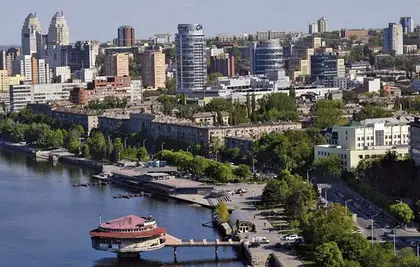The city strikes you with its straight, broad streets, half-empty compared to Kyiv’s busy lanes, which bare a resemblance to the wide Dnipro River that flows through and divides the city.
Originally named Yekaterinoslav, the city was founded in 1776 by Catherine the Great, who planned to turn it into the Russian Empire’s southern capital. That never happened and the city remained only of local importance until the early 20th century.
JOIN US ON TELEGRAM
Follow our coverage of the war on the @Kyivpost_official.
Its glory days came under Soviet rule, when the city was renamed after the Dnipro River and the October Revolution activist, Grigoriy Petrovskiy, and became a large industrial center, taking advantage of the region’s iron ore deposits. As the Soviet Union’s rocket building capital, Dnipropetrovsk was a closed city, kept off the maps and shrouded in secrecy.
The city was also home to some of Ukraine’s most powerful people, including billionaire oligarchs Viktor Pinchuk and Igor Kolomoiskiy, former Prime Ministers Yulia Tymoshenko and Pavlo Lazarenko, and former President Leonid Kuchma. This “Dnipro mafia,” as locals call it, arguably boosted Dnipropetrovsk’s economic and political influence during the 1990s and early 2000s, but provided little benefits for the city. A new tour, focusing on the lives of the two former prime ministers, revisits those times.
Fortunes changed with the rise of Donetsk and economic transition. Plants and factories have shut down, and the city is slowly losing its inhabitants, giving it a somewhat abandoned feeling.
Dnipropetrovsk combines imperial, communist and modern architecture, but is dominated by a strong Soviet spirit. This is reinforced by the many monuments to revolutionary leaders. Lenin watches over the main square while his colleague, Petrovskiy, greets those arriving to Dnipropetrovsk by train. The statue’s hand points left, which has led to a popular joke saying that Petrovskiy is pointing to Ozyorka, the huge central market two blocks from the station, recommending it for shopping.
The typical Dnipropetrovsk tour starts with a walk down the main avenue, named after Karl Marx, which starts from the railway station and runs parallel to the Dnipro through the whole city center. Several tram stops from the station is Globy Park, a green spot with a duck pond and entertainments for kids. Make sure to visit the playground to the right of the main entrance, with its strange yet amusing fairy tale figures. The Wolf, for instance, is twisted in a way suggesting he has a hernia, while Piglet’s red eyes hint that Winnie-the-Pooh’s best friend is stoned.
The city’s best river panorama can be seen from Shevchenko Park, which is connected to Monastyrskiy Island by a footbridge. Legend has it that it hosted a settlement of Byzantine monks in the 9th century, and that Kyivan Rus ruler Olga stopped there on her trip to Constantinople in the 1oth century. Unfortunately, the island’s coastline is now spoiled by large amounts of trash.
A few steps further is Europe’s longest embankment (20 kilometers long), which offers a fascinating water view and is the go-to-place for locals wanting to show off their trendy clothes, relax with friends or meet someone.
On the way you can see the multi-million dollar Menorah, said to be the world’s largest Jewish community center – a testament to Dnipropetrovsk’s long history as a center of Jewish life in Ukraine, and the 50,000-70,000 Jews who still live there. The center houses a hotel and hostel, but is still working on filling its 22 stories with exhibits, offices and eateries.
Finding good places to eat presents a challenge. Prices differ little from Kyiv, but service is often disappointing. One of the more popular spots is the cozy Myshi Blyahera café. It offers meat dishes for Hr 45-59, a pot of tea for Hr 19-29 and wine for Hr 28 for a glass.
If you’re willing to pay more, try the legendary Reporter restaurant, which used to be the fanciest and most expensive restaurant in town in the mid-2000s. It still has a sign asking clients to keep their bodyguards out of the dining hall, but prices are now more reasonable. A piece of apricot pie goes for Hr 35 and tea pots go for Hr 22 to Hr 30, though meat dishes can climb up to Hr 290.
For drinks, visit the historical landmark, Tsepi pub, a popular hangout for Western-oriented youths in Soviet times.
Most hotels in the city center are high-class, or at least claim to be. Axelhof Hotel, opened in 2011 by a controversial local businessman Hennadiy Axelrod who was murdered in a bicycle drive-by in 2012, is costly but offers nice rooms. Dnepropetrovsk Hotel is a cheaper option. The rooms are disappointing but great location on the river embankment means it has a great view.
That said, Dnipropetrovsk is no Paris and does not require a week of city walks and museum tours. While too Soviet for my taste, it is still worth a visit to feel the city’s charmingly intense spirit.
Kyiv Post staff writer Daryna Shevchenko can be reached at [email protected], and on Twitter at @Iskrynka.
You can also highlight the text and press Ctrl + Enter




